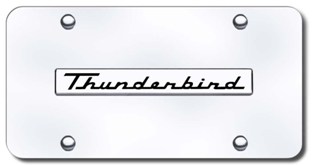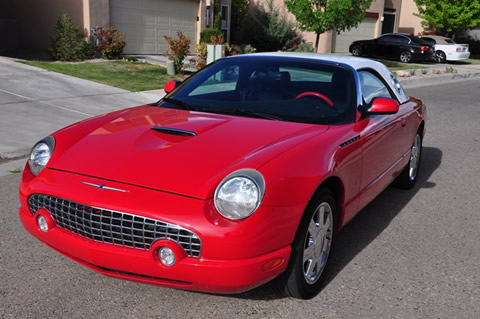
Welcome to my Ford Thunderbird Website
by ABQTBird (Tom Gugliotta)
History of the Ford Thunderbird 1955 to 1966 and 2002 to 2005
Introduction
The Thunderbird was produced by Ford Motor Company from 1955 to 1997 and again. from 2002 to 2005. Thunderbird enthusiasts classify the cars in.to "generations" that span certain. model years. I will focus primarily on those cars produced from 1955 to 1966, as well as the reintroduced "retro-bird" that was produced from 2002 to 2005. The cars produced from 1955 to 1966 have the highest following among restoration enthusiasts because of their unique styling, high performance, and high availability of reproduction parts.
First Generation (1955 to 1957)
The Ford Thunderbird began life in February 1953 in direct response to Chevrolet's new sports car, the Corvette, which was publicly unveiled in prototype form just a month before. Under rapid development, the Thunderbird went from idea to prototype in about a year, being unveiled to the public at the Detroit Auto Show on February 20, 1954. Like the Corvette, the Thunderbird had a two-seat coupe/convertible layout. Production of the Thunderbird began later on in 1954 on September 9 with the car beginning sales as a 1955 model on October 22, 1954. With the Thunderbird considered a success, few changes were made to the car for 1956. The most notable change was moving the spare tire to a continental-style rear bumper in. order to make more storage room in. the trunk, and an optional porthole in. the removable roof was offered and often selected by buyers. However, the addition of the weight at the rear caused steering issues. The spare was moved back to the trunk in 1957 when the trunk was restyled and made slightly larger. The Thunderbird was revised for 1957 with a reshaped front bumper, a larger grille and tail fins, and larger tail lamps. The 312 cu. in. V8 became the Thunderbird's standard engine, and now produced 245 horsepower. Other, even more powerful versions of the 312 cu. in. V8 were available in.cluding one with two four-barrel Holley carburetors and another with a Paxton supercharger delivering 300 horsepower. Though Ford was pleased to see sales of the Thunderbird rise to a record-breaking 21,380 units for 1957, company executives felt the car could do even better, leading to a substantial redesign of the car for 1958.
First Generation Thunderbirds

1955

1956

1957
Second Generation (1958 to 1960) "Square Birds"
Although the Thunderbird had been considered a rousing success, Ford executives-particularly Robert McNamara-felt that the car's position as a two-seater restricted its sales potential. As a result, the car was redesigned as a four-seater for 1958. Though retaining a design as a two-door hardtop coupe/convertible, the new Thunderbird was considerably larger than the previous generation, with a longer 113.0 inches wheelbase to accommodate the new back seat. The increased size also in.creased the car's weight significantly by close to 1,000 pounds. Along with a new, more rigid unibody construction was new styling, including dual headlights (for a total of four), more prominent tail fins, a bolder chrome grille, and a larger, though non-functional, hood scoop. Powering the Thunderbird was a new, 300 horsepower 352 cu. in. V8, available with a 3-speed manual or automatic transmissions. With 37,892 sold in 1958-outselling the previous model year by well over 16,000 units-the new Thunderbird began a sales momentum previously unseen with the car. It was also history-making, becoming the first individual model line (as opposed to an entire company) to earn Motor Trend "Car of the Year" honors. Little was changed between the three years other than cosmetic features such as the grill, taillights, and chrome accents. In the 1959 model, a fully automatic retractable convertible top was introduced that used a system of relays and switches to make the top fully retractable into the trunk. This consumed most of the trunk space, but left the 'bird with a sleek look uninterrupted by a folded back top. 1960 saw the in.troduction of a sliding metal sunroof, of which only 2536 were made out of 92,843 for that model year. The second generation T-birds gained the nickname "Square Birds" for their box-like appearance.

1958 Thunderbird Convertible
Third Generation (1961 to 1963) "Bullet Birds"
The Thunderbird was redesigned for 1961 with sleeker styling that gave the car a distinctively bullet-like appearance, earning them the nickname "Bullet Birds". A new Engine, the 390 cu. in. V8, was the standard and only engine initially offered in the Thunderbird. The V8 produced 300 horsepower and was mated to a 3-speed automatic transmission. The new Thunderbird was immediately well received with 73,051 sold for 1961. The car was 1961's Indianapolis 500 pace car and was featured prominently in US President John F. Kennedy's inaugural parade.
A vinyl-roofed Landau option with simulated S-bars was added to the Thunderbird for 1962 as was a Sports Roadster package for convertible models. The Sports Roadster included 48-spoke Kelsey Hayes-designed wire wheels and a special fiberglass tonneau cover for the rear seats which gave the car the appearance of a two-seat roadster like the original Thunderbird. The Sports Roadster package was slow-selling due the high price of the package and complexity of the tonneau cover, resulting in. few Thunderbirds being equipped with it. Newly optional for 1962 was an upgraded version of the 390 cu. in. V8 called the "M-Code" (a nickname used in. reference to the letter M used as the engine code in the VIN in cars so equipped). The M-Code version of the 390 cu. in. V8 was equipped with three two-barrel Holley carburetors and could produce 340 horsepower. M-Code V8 Thunderbirds are exceptionally rare with only 200 being sold between 1962 and 1963. For 1963 only, Y-code cars could come equipped with the same 390 cubic inch V-8 also equipped by the factory with tri-power carburetors only if the buyer desired air conditioning.

1962 Thunderbird Sports Roadster showing retractable
convertible top
Fourth Generation (1964 to 1966) "Flair Birds"
For 1964 the Thunderbird was restyled in favor of a more squared-off appearance, which was mostly evident when viewing the car from the side or rear. Hinting at its roots in the previous generation Thunderbird that it was evolved from, the new model retained a similar grille design with dual headlights and a 113.2 inches wheelbase. As before, the new Thunderbird continued to be offered in. hardtop, convertible, and Landau versions. The 300 horsepower 390 cu. in. V8 continued as the standard engine for the Thunderbird while a higher compression, 330 horsepower version of the engine was optional. Both V8s were paired with a 3-speed automatic transmission. For 1965, sequential turn signals were added, flashing the individual segments of the broad, horizontal tail lights in sequences from inside to outside to indicate a turn. Also new for 1965 were standard front disc brakes.
Even though it was the last year of the generation, 1966 saw a stylistic revision for the Thunderbird highlighted by a new egg-crate style grille with a large Thunderbird emblem at its center and a new rear fascia with the brake lights restyled to appear as one unit. Engine choices were also revised for 1966. The base version of the 390 cu. in. V8, equipped with a single four-barrel carburetor, produced 315 horsepower. Newly optional and taking the top position for performance was a 345 horsepower 428 cu. in. V8. The 428 cost only $86 over the base Engine, and was a popular option.

1964 Thunderbird
Eleventh Generation (2002 to 2005) "Retro-Birds"
After being on hiatus for several years, Ford introduced a new Thunderbird for 2002. Returning to the original formula for the Thunderbird. The latest version had a two-seat coupe/convertible layout like the first-generation Thunderbird and retrofuturistic styling to match. The eleventh generation Thunderbird was built at Ford's Wixom Assembly Plant. The sole engine of the Thunderbird was a Jaguar-designed AJ-30 3.9 L DOHC V8, a short-stroke (85mm) variant of the Jaguar AJ-26 4.0 L V8, making 252 horsepower and 267 lb·ft of torque. The engine was mated to Ford's 5R55N 5-speed automatic transmission. The AJ-30 V8 was replaced by the AJ-35 in 2003 and later Thunderbirds, bringing with it variable valve timing (VVT) and electronic throttle control (ETC) as well as 280 horsepower and 286 lb·ft of torque. Complementing the extra power and torque provided by the AJ-35 V8, a manual shift feature for the 5-speed automatic called SelectShift was available as an option in 2003 and later Thunderbirds. With sales dropping off significantly after its first model year, Ford decided to make the 2005 model year the Thunderbird's last with no scheduled successor. Coincidentally, Ford made its final edition coincided with its 50th anniversary and offered special anniversary editions.
